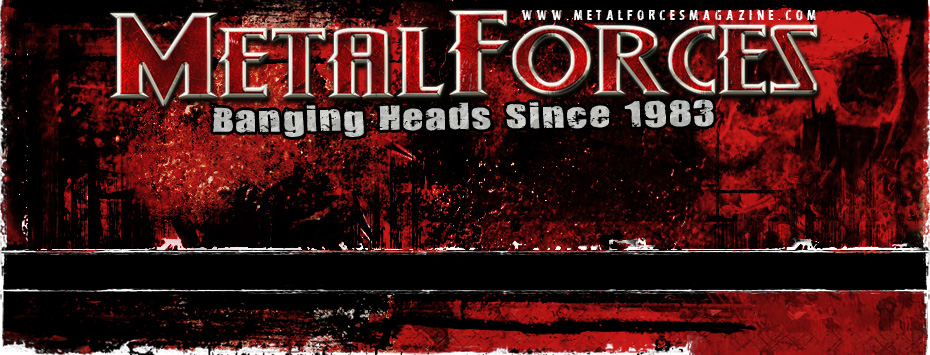
JOB FOR A COWBOY – A Global Shift
Anthony Morgan
November 2014
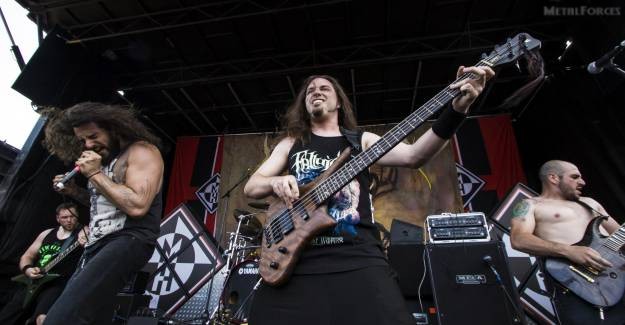 Job For A Cowboy live at the San Manuel Amphitheater in San Bernardino, California on June 29th, 2013 |
![]()
American death metal outfit Job For A Cowboy hired Nick Schendzielos during early 2011 to handle bass duties, previous member Brent Riggs having occupied the position since 2004. Figuring among the line-up of Denver, Colorado-based death metal assortment AinMatter, Nick caught the attention of grindcore act Cephalic Carnage, Denver also being home to the aforementioned.
“Cephalic Carnage is an international touring band, who’s on Relapse Records,” Nick informs. “Their bassist quit (Jawsh Mullen), so they hired me. I’ve been touring the world with those guys, and meeting friends. We toured with Despised Icon, and that’s when I met Al from Job For A Cowboy (Al Glassman, rhythm guitars). Then he ended up going into Job For A Cowboy, and then I was doing some session work down in Arizona. The drummer that was doing the session work… Well, there was two of them. One of them was Sam Paulicelli, who’s now in Decrepit Birth and has got funny YouTube videos.
“The other drummer was Jon Rice from Job For A Cowboy, so Jon and I talked. ‘Oh yeah, Al. He’s awesome, a good kid. We toured with him, with Despised Icon.’ Then a month later from that, their old bassist Brent just walked off in the middle of a tour. Then they called me up, like ‘Hey, we know you’re not as busy with Cephalic. We’ve got this EP that we already have scheduled, and then this tour, and all of this stuff, so we could really use some help.’ I was like ‘Okay, cool,’ so we just kind of tried it out. It was a really good fit. Everybody’s humour clicked, and it was a lot of fun. My band Cephalic was willing to work with me on the schedule, and so it’s been cool.”
The scheduled EP in question would surface under the title Gloom, arriving in June 2011. “I remember getting together, and it was colder than hell in Boston (Massachusetts),” the rhythmist shares. “I remember thinking ‘Holy shit, these are really technical riffs.’ I didn’t really kind of expect that so much, because I hadn’t really ever gotten into the band’s catalogue. I remember it being a challenge bass-wise to get the technicality up there. Cephalic actually had tons of crazy riffs and lots of speed and stuff too, and it was with (Jason) Suecof again down there. Experiencing him for the first time definitely tripped me out, because he’s a kind of whacky cartoon character-like dude.”
Demonocracy marked the first Job For A Cowboy studio full-length to feature contributions from Nick. Issued in April 2012, it was the band’s third overall. “With that one, we had a lot more time,” he recalls. “I remember guitars taking like a month (laughs). It was literally like three weeks of guitars, and that was kind of a similar experience – kind of the same thing. It was really cool just to get to live with these guys, because you go and you live with these guys. We went down to Florida, and all lived together as a band; we hung out, and watched our favourite TV shows together. You really kind of bond with each other in that type of experience, and you do with the engineer too. That’s a big part of it as well.”
November 2014 effort Sun Eater happens to be its successor. “We essentially came home from this Rockstar Energy Drink Mayhem Festival, and decided that we wanted to write something different this time around,” the four-stringer notes. “We actually even had the idea of what we wanted to do; on the Mayhem tour, we were talking about it. We kind of had this idea for a while, and we ended up deciding to go for it. Even up until the last day of Mayhem, we started talking about the actual storyline of the album, of this particular character that the album is about. Then with that in mind, the concept of this character – which is the Sun Eater character – we went home, and everybody kind of started putting ideas together.
“Tony (Sannicandro, lead guitars) and Al did the majority of the songwriting, as far as putting the actual riffs together. Tony had most of the riffs; he would be kind of the riff factory, and wrote the riffs in mind of the concept of each song. Then him and Al would get together and work out the kinks, and Al would try to make the songs flow together better. Then they would send the songs to Tony’s brother Peter, who is really good at programming drums. He’s real fast; you tell him what you want, and then he would program the drums. Then they would email the songs to Jonny (Davy, vocals) and me, because we are across the planet essentially (laughs). I’m in Colorado, Jonny is in Arizona, and then there’s Danny Walker (Intronaut), who we had doing the drums. We were sending him the tracks too, and he’s in LA (Los Angeles, California). With everybody split up all over the place, email is the only way really. Using this technology, we could actually get this record done.
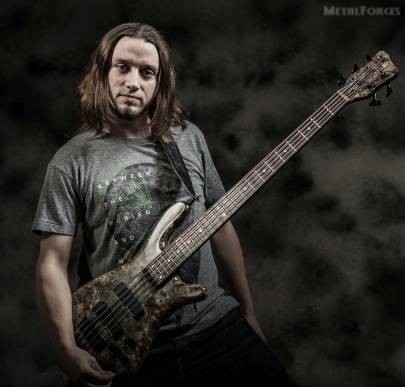
|
“Anyway, they would all email the tracks and then we would take them, import them into our computer, and play with them, chop them up, pull off the distortion, add different effects, and rearrange stuff. Then we sent all that back to Tony and Al, and then they would make further revisions. Then we actually went down to Florida and did pre-production on the songs, and then did the actual production with Jason Suecof. That was the writing process this time around, but it was a much more deliberate process. It was a much more… We knew what we wanted to create beforehand; instead of just kind of writing each song and letting each song be what it was, each song – on this record, anyway – had a specific purpose.”
Full-length albums three and four as well as a lone EP now boast Nick’s services, and so penning compositions was theoretically a more comfortable process. “This time, it was definitely easier and more cool,” he confirms. “I was more comfortable, and the same with Tony. I think all of us had really decided that we knew what we wanted to make this time around, and so it had this intention behind it which just made the whole process a lot more… I guess a lot more artistic, I would say – if I could be so bold as to use that word. I think it’s a lot more artistic in the aspect of that we weren’t trying to prove something this time around, which is funny because I think that this record actually does prove something.
“It proves that we are sort of a legitimate death metal band, and that it’s not a guilty pleasure to listen to us any more. I think it’s along the lines of we didn’t have to have a million riffs per song and to have nothing repeat, and to have different details on every single little riff, and all of that kind of stuff. We could take the concept of somebody that thinks the fluoride in the water systems is being specifically put there to crystallise our pineal glands so that we’re not aware of the manipulation of all of our essential awarenesses of what’s going on with the planet, and that kind of stuff, and that type of a concept.
“Jonny would handle conspiracy theories and that kind of stuff in the lyrics before from a much more political standpoint, but this one’s from a much more artistic standpoint because he’s imagining it from this different person’s perspective, and writing it from this different person’s perspective. I think it was just in that way. I know being artistic and art itself is subjective but I think that’s one way it came out more artistic, is having that freedom to use a lot more imagination this time around.”
As referenced, prior to Sun Eater’s issue, the bassist feels that Job For The Cowboy were a guilty listening pleasure. “(Laughs) I think that it was, man,” he reaffirms. “I don’t even know if ‘guilty pleasure’ are the correct words to use, but I think you had to have your ducks in a row. If you said that you like JFAC or if you were wearing a Job For A Cowboy shirt, there’s this stigma behind it, like ‘Oh, that’s that deathcore band that wears really, really skinny jeans and has haircuts with the swoops the eyes. They just play breakdown after breakdown after breakdown.’ I think that that stigma and that image was stuck in people’s minds, even though the band hasn’t put out anything resembling deathcore in eight years. I think in that aspect, even if somebody liked Demonocracy – it’s a tech death record, a total tech death record – they had to listen to it, and hide it from their friends (laughs). Not everybody. You know what I mean?
“I think with this record now though and the word that’s going around about it – that it’s a straight-up, legitimate, awesome record – the old fans like it and new fans like it, and the death metal elitists are finally conceding that this band is really awesome. It’s Danny Walker on drums, and he’s a pretty legendary person. I think that finally now, it’s like ‘Oh yeah, that new JFAC is cool.’ It’s kind of like the reverse of Metallica or something; you’re supposed to like old Metallica and not like Load (June 1996) and ReLoad (November 1997) and St. Anger (June 2003), but with us, from the death metal elitist point of view it’s not okay to like the old JFAC, but it’s okay to like this new stuff because it’s legitimate.”
Critiquing Job For A Cowboy’s discography as a whole, describing either of the ensemble’s outings as being deathcore in nature seems tenuous at best. “I think you are right,” Nick agrees. “I think that people like you have gotten it all along (laughs), but I think there’s this kind of elitism that’s out there where those people hadn’t really gotten it. If you listen to Genesis (May 2007), Genesis doesn’t have a single breakdown on it. In my opinion, when you combine the genres of death metal and hardcore for deathcore, the ‘core’ side of it essentially means breakdowns, and there are no breakdowns on Genesis. I understand completely what you’re talking about. It’s not what that is, but for whatever reason, people weren’t even willing to give the albums a listen maybe is probably the real truth of it.”
The issue is once you’re labelled as a group and deemed to belong to a specific genre, music fans will have a preconceived opinion of your material prior to hearing it. “Exactly,” the rhythmist seconds. “That’s a 100% true, dude. A 100%.”
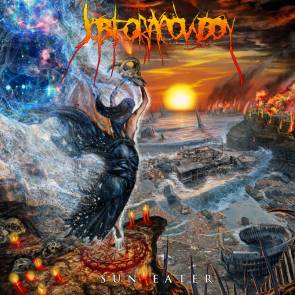
|
Returning to the topic of Sun Eater, the album’s corresponding artwork depicts its titular character. “If you look at the album artwork, that’s what the album’s about,” Nick elaborates. “On the cover there’s this character, and she is on the edge of this cliff. She’s holding the ram’s head, and it looks like she’s levitating off of the ground – like levitating into the cosmos – peering over this sort of destruction that exists on the planet in this canyon and this big sea. The concept is is this person actually on the edge of this cliff holding a magic séance and levitating into the cosmos while directly getting her energy from the Sun as the world around her crumbles? Or is this all a hallucination and none of it is real, and she’s just whacked out on drugs at the edge of a cliff, and about to fall off and die? That’s kind of the concept, this whole perception of the world through the eyes of this person who believe that they’re able to get their energy directly from the sun. They believe that all of the water is being poisoned and all of the food is being poisoned, kind of like this extreme, almost paranoid schizophrenic view of the world.
“Each song is about a particular topic through the eyes of this particular person on a journey that doesn’t exactly end well for them. I don’t know if you’ve ever seen American Psycho (2000), but at the end of it you’re left not knowing whether or not all of that was a fantasy, or if it really happened. That’s kind of what we wanted to do, so it’s kind of a trippy, almost psychedelic type of… Almost like a The Wall (November 1979, Pink Floyd) type of record for us, something totally different. Something totally different from the highly politically charged records that we have previously done.”
Viewing the artwork, the female character can arguably be interpreted as about to throw the ram’s head into the abyss, which could perhaps be symbolic of a musical change. “That’s really cool,” the four-stringer commends. “I like that better, and you know what? Maybe I’m gonna stop telling people about what the art means, because your interpretation sounds cooler to me than what ours was (laughs). I think that that’s something about art and music in general, that if the artist always explains what their expressions mean and what they’re about, does it taint your perception of it? That’s a pretty awesome interpretation. Maybe that’s something that just kind of happened subconsciously. We did talk about that, that the ram’s head started out with the Doom EP (December 2005) kind of simple.
“Then there was Genesis and it was much more grandiose, and then with Ruination (July 2009) it’s falling from the throne, and then with Demonocracy the ram’s head is no longer the entire head. It’s actually just a piece, like a headpiece crown sort of a thing on top of Lady Justice, and then with this evolution of it, leaving the head all together. I like the idea of where you’re coming from, that it looks like she’s about to throw it off to signal that we don’t need that any more. That’s awesome. I think that’s great man, and perceptive of you.”
A good interpretation, but nevertheless not what Job For A Cowboy’s members had in mind. “Right,” Nick responds. “I guess I hadn’t even really thought about that, but if you look at her hand, you can’t tell whether she’s lifting it up and using it to get power, or if she’s pushing it away from her and using the power to throw it over the cliff. I guess that is still up to interpretation.”
Offering a a definitive interpretation for Sun Eater’s artwork is perhaps best left to Tony Kohl, the man responsible for its design. “We essentially gave him the concept, and he did an incredibly wonderful job with the time that he was given,” the bassist enthuses. “The original artist Brent Elliot White, he had done Ruination and Genesis. He completely just ripped us off; we paid him a down payment of like $1,500, but he just stopped replying. He just kept the money, and didn’t give us any artwork. I think we had like a week or two weeks or something to get album art.
“We gave Tony the initial concept but we didn’t go into tons of detail with it, so I think that some of it is his interpretation for sure from the initial emails. The overall concept of the character is her being on the edge of a cliff staring at the sun, and kind of having a mix between the third eye type of artwork that he does, and the kind of more ritualistic… I don’t want to say demonic, but that side of his art. It came out really cool though, man. The more I look at it and the more time passes, the more I like it.”
Critiqued against past Job For A Cowboy artworks, viewers can look at Sun Eater’s artwork longer and discover new details to scrutinise. “I think that’s true,” Nick concurs. “Maybe that’s because there are more micro-details, and it’s standing at a much bigger scene. With the other ones, the character would be ten feet in front of you and the focal point of all of the stuff that’s around them. With this one, you get the whole depth and feel. It goes all the way out to the sun at the end, and you get this much more distant view, kind of like looking further. You get a much further vantage point.”
Artist Brent Elliot White ‘ripping off’ Job For A Cowboy is seemingly out of character, when one considers the fact that the man had designed several past artworks for the ensemble. “I don’t know, man,” the rhythmist ponders. “That just blew us away, dude. I don’t know. I was really looking forward to seeing what he was gonna do with this idea that we gave him. I don’t know. I guess maybe he was having some personal issues in his life or something. I don’t know. I definitely wanna get the money back, though (laughs). That’s not fair (laughs).”
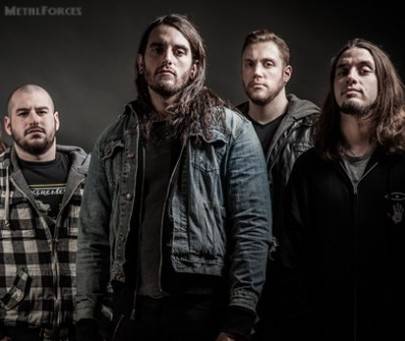
|
Taking Nick’s words to be truthful on the matter, it would be surprising if the artist had solely ‘ripped off’ Job For A Cowboy, and not several other groups in the process. “I would just say that if I were a band and I was gonna hire him, I would not give him any money until you saw actual art being done – actual sketches being done – at this point,” Nick warns. “Before this record, I would given him a A-plus, 100% review to anybody because I had total trust in him, but now he’s completely violated that trust.”
Such happens are a great shame, especially in light of the reputation Brent Elliot White has built over the years, working with a number of high profile clients within the metal realm. “Totally, man,” the four-stringer replies. “He was one of the top artists in the game. If he pays us the money back then he can get rid of the stealing aspect of it, but as far as we see it right now, he stole it from the band.”
Weighed against past outings, Sun Eater is a more varied affair. “I would say that it’s more dynamic, it has more character, it has more space, more versatility, different textures, much more different tempos, more variety, and – in a lot of ways – more variety in the tone, and definitely a stronger I guess you’d almost say a progressive vibe to it,” Nick augments.
Sun Eater’s press release described rhythm guitarist Al as ‘a driving force behind the band’s sound.’ “Al’s like the glue of the band,” the bassist offers. “He has really dedicated his life to making Job For A Cowboy work. His house – it was in Boston, but now it’s in New Hampshire – has always been the home base of the band. Since everybody’s so spread out, we fly to one place, which is always his house. He keeps the van, and all of the gear, and all that kind of stuff. When it comes time to write, he’s the guy that keeps the iron hot. He’s the guy that keeps pushing, pushing everybody to get the material written. It’s kind of hard being so far apart; you can’t have a weekly practice, or a two or three times a week practice with everybody where you get in the same room. He’s really got to crack the whip, so that’s what he does. He stayed on top of Tony, and they stayed on top of working together, and committed themselves to making this record happen.”
Lead axeman Tony felt that he ‘took a much more melodic approach than Demonocracy’ on Sun Eater, meanwhile. “I think with him, it was kind of the same thing,” Nick reckons. “As you mature as a death metal musician you realise that it’s okay to play more melodically, and then it doesn’t have to be so brutal or dark sounding I guess the whole time. The melody itself can bring that out, and so I think that it’s just less riff-oriented. Less of a riff salad, and more about bringing out the individual character of each song. I think he did a really good job of that this time around.”
Tony particularly mentioned ‘focusing on the structuring and the layering that would complement the story.’ “Basically, he would try to emulate,” the rhythmist explains. “There would be this song about trying to get your energy from the sun, and so he would imagine I guess the scenario in his mind. Maybe he would see this kind of image, and then try to play something that matched that feeling. I guess that’s why a lot of it has that slower, kind of brooding texture to it, because he’s imagining this character’s life and these different circumstances. I think that’s a hard thing to do, and that’s something that was totally subjective – even for him – as to why he wrote those particular riffs and melodies for each different concept. That’s something that’s totally different, too.”
Nick believed that Al ‘really used a lot of foresight in his revisions during the writing process, creating ample room for’ him ‘to mood-out the tracks with bass that you can actually hear.’ “That was really cool this time around,” he praises. “Al and them would be like ‘Hey, we wanna make sure that there’s room in there, that there’s space in there.’ I think that some of the slower tempos and keeping some of the riffs simpler left me room to be able to have this third – if you will – melodic voice that kind of like serves as a sort of counterpoint. Not counterpoint as in the music theory aspect, but just a supplemental melodic voice on the record. He’d have parts, like in-between ‘Eating The Visions Of God’ and ‘Sun Of Nihility’, that he knew he wanted to have – like this bass connection thing, little things like that kind of all over the record. He’d be like ‘Oh, this would be a good spot for you to go off from the guitars,’ and do your own thing right there. He left tons of room all over the record for me to do that, and I think that that’s a big difference between the last record and this one.”
Evaluating the contribution of each member towards Sun Eater, one mustn’t omit frontman Jonny. “Jonny kind of stays out of the musical side of it,” the four-stringer notes. “If something really bothers him, he’ll mention it, but that doesn’t happen very often at all. Jonny’s focal point a 100% is the lyrics to the songs, and so we don’t get any say in that. We let him completely control that. It’s kind of like this mutual respect, like ‘You guys do the music, and I’m gonna do the lyrics.’ He just slaved away, coming up with what I think are his best lyrics. They’re simpler, and there’s a lot more repetition. I think he really did a great job of writing really catchy vocal lines this time around.”
Jonny seems conspicuously absent from Sun Eater’s promotional cycle at the time of writing. “I forget the exact thing what he’s training for is, but he works with the old guitar player from Job For A Cowboy – Bobby (Thompson),” Nick divulges. “He’s actually still well connected with the band; he’s a great guy, and his parents-in-law own the restaurant / coffee shop that Jonny works for. He’s been training for some new position there, or something – I wanna say head chef or something like that. I’m not sure what the exact position he’s been training for is, but he’s working I wanna say six or seven days a week. He’s just slaving away, so we have stepped up. He was like ‘Hey, are you cool with doing a lot more press? I just don’t have the time to do it right now’ and all that kind of stuff.’ We’re just waiting for him to wrap up with that job, because we’re all ready to get out and tour.”
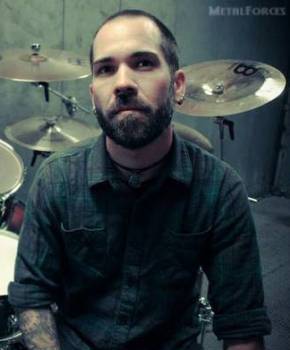
|
As referenced throughout this feature, stepping behind the drumkit was Intronaut sticksman Danny Walker. “We had a short list of drummers that we knew we wanted that would fit the style of this new music, and Danny was pretty much our first choice,” the bassist recounts. “We knew we wanted to have somebody have this kind of like tastier style, and he’s one of the tastiest drummers. He can play everything. With the Intronaut stuff, he’s got so much groove and character to his playing, and then I love his handwork. His cymbal work is some of the tastiest stuff that I’ve ever heard, so we knew that we wanted to have somebody like that, who had that dynamic range. It was really easy; we just called him up, and was like ‘Hey, man. Do you wanna come record this record with us?’ He was like ‘Yeah,’ and that was it.”
Previous drummer Jon Rice parted ways with Job For A Cowboy during August 2013. “Jon essentially has always been a child of the 70s; he loves 70s rock,” Nick cites. “He likes Pentagram and stuff like that where it’s a lot more chilled out on the drums, even though he’s an amazing technical drummer, he fills in for bands like 1349, and he’s got a pretty wide musical taste. He really wanted to get into something different, so it worked kind of perfect. When we did the Mayhem tour, there was this band called Scorpion Child. He hit it off really well with those guys, and he’s really good friends with them. We all really dug their music, which is kind of this heavier, Led Zeppelin type of thing. Then actually, he wanted to make that change. He wanted to play a totally different style of music, and so no bad blood.
“We’re still really good friends with him. He also fills in for Cephalic Carnage as well (laughs). He’s one of the drummers on the roster, but he’s a great dude, and we’re still friends. We’re stoked. As far as live for Job For A Cowboy, we’re looking to bring Danny Walker out with us to play these Sun Eater songs, but we’re not stepping on his band Intronaut’s toes. We have to work the scheduling out around it, but when you see us again, we’re trying really, really hard to make it be Danny Walker.”
Whether Danny becomes a permanent fixture behind the drumkit is uncertain. “We would love to keep it with just Danny Walker, even if that meant having to work around his schedule with Intronaut,” the rhythmist observes. “Intronaut’s got some guys in it that means it can’t be a ten month a year band, because Sacha Dunable’s building guitars. He’s building these awesome guitars for his own guitar company that he’s starting, so there’ll be time for Danny to tour. He was such a creative part and such an important part of the way Sun Eater came out that we want him to play the songs with us live.”
As has been the case since Ruination, Job For A Cowboy recorded at Audiohammer Studios in Sanford, Florida with producer Jason Suecof. “Very cool, very low key this time around,” Nick describes. “And much faster I think, because of the pre-production work that we did. It was very comfortable. He was very involved in the process. He helps us push ideas along, and he knows how to get the best take out of you, and he knows how to get the best ideas out of you. He’s been working with us for six years now, and it’s kind of the same thing. I don’t think you’d ever see us go with anybody else.”
Past interviewees have spoken well of Jason, but have often mentioned that the producer isn’t one to mince his words. “He’s not afraid at all, and he’s a phenomenal musician,” the four-stringer compliments. “He’s a really, really good musician, so when he tells you that something sucks, he’s probably right (laughs), like 95% of the time. There’s only 5% of the time that you’re like ‘No, really like this. I’m gonna keep it.’ When you tell him that, if you’re absolutely like ‘No, this is staying,’ at the end of the day we are paying him, and he works for us. So, he will concede in those areas, but he’s right most of the time. Pretty much all of the time, he’s right about a part (laughs).”
‘Sun Of Nihility’ was earmarked as Sun Eater’s inaugural single. “That’s my favourite song on the record,” Nick discloses. “I took a small piece of one of Tony’s riffs that caught my attention when I was listening back to it, which was originally distorted. As I pulled the distortion off of it, I really liked the flow of it as a clean tone. I started to build layers and layers on top of it with all of these filters and fun things on my computer, and then I wrote this bass line for it. I was really worried that the other guys were gonna be like ‘What the hell is this?,’ but I sent it back to them all reworked out and everybody loved it.
“They were like ‘This is really cool – totally different from anything we’ve ever done – but we really like it.’ That kind of continued to go on through the recording process. Everybody ended up really liking that stuff; the label, our management, and everybody in the band even decided ‘This is the first thing that we wanna put out for people to hear what we’ve been up to for the last year and a half.’ It represents just how far the band has progressed from the albums of before.”
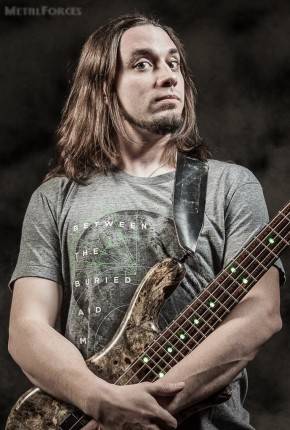
|
Should a music video be created for one of Sun Eater’s compositions, helming the piece will be Michael Panduro, having previously spearheaded the clip for ‘Tarnished Gluttony’ (from Demonocracy). “We’ve developed a relationship with Michael Panduro,” the bassist reasons. “I hooked him up with Job For A Cowboy, because he had worked with Cephalic Carnage. He did ‘Ohrwurm’ for us (from August 2010’s Misled By Certainty). All of us have collectively decided that for any videos in the future, it’s gonna be Michael Panduro. We love his style. I think it’s because the traditional music video of having the band play in a warehouse with a strobe light and it’s brutal, or you’re in a field or whatever, are so clichéd and played out and beaten to death that we don’t wanna have anything to do with it, and neither does Michael Panduro. It’s funny, because he lives in Denmark. It opens up things for everybody creatively to be like ‘What can we make a video about where you don’t have any of the band members in it?,’ and that’s what we’re gonna be going for again.
“He said he’s got a concept in mind for one of the songs that he wants to do. We’re still working out some budget things, because we wanna give him a much bigger budget than he had for ‘Tarnished Gluttony’. He took what we gave him for that and made this amazing video, so we’re trying to get him as much money as we can – he’s just phenomenal. That’s the plan, another Michael Panduro video. Pretty much he’s gonna be doing any video you ever see from Job For A Cowboy, and we love that. We’re definitely onboard with that.”
Perhaps Brent Elliot White can return Job For A Cowboy the money it paid him, and that can go towards funding a music video. “Yeah,” Nick laughs. “A creative solution.”
Cephalic Carnage plan to cut a seventh full-length, meanwhile. “Now… Shoot, man… It’s been four years since we put out a record (Misled By Certainty), so that’s something that we’ve gotta get going on,” the rhythmist acknowledges. “I’ve got maybe about one or two songs, and so we’re just trying to get a consistent writing schedule going. We went and just played Hell And Heaven Fest with Cephalic down in Mexico, and that was amazing. We were lucky enough to have Danny Walker play drums with us for that as well, so yeah, there are plans for Cephalic to definitely write a new record and get a new record out in 2015. Then hopefully, I can do another Cephalic Carnage and Job For A Cowboy tour. I’ve done two of those, actually; one where Job For A Cowboy was headlining, and then another one where Between The Buried And Me was headlining. It’s super-fun, though. That’s one of my favourite things, is to get to do double duty and bring both of those bands out on the road together.”
Pulling double duty isn’t tiresome for Nick. “Not too bad,” he figures. “When we did it, it was still maybe a total of an hour and 40 minutes of playing, but then there was Dan (Briggs, bass) from Between The Buried And Me. Their set was like two hours long, so even though I was playing with two bands, he was still playing longer than me (laughs). I think once you’re up there and warmed up, you can play a lot longer than you think you normally could.”
Sun Eater was released on November 7th, 2014 in Germany, Austria, and Switzerland, on the 10th in the rest of Europe and subsequently on the 11th in North America, all via Metal Blade Records.
Interview published in November 2014.
Related Posts via Categories
- SCOTTISH SICKNESS – A Report On The Scottish Death Metal Scene, Featuring BRAINBATH, PUTRID FATE And RANCID CADAVER (October 2022) | Features / Interviews @ Metal Forces
- LARVAE – Join The Hardcore Cult! (June 2022) | Features / Interviews @ Metal Forces Magazine
- TRENCH FOOT – Sacrificing Morals For Gory Obscenities (June 2022) | Features / Interviews @ Metal Forces Magazine
- L.A. GUNS – Trigger Happy (March 2019) | Features / Interviews @ Metal Forces Magazine
- CANCER – Crimes So Evil (November 2018) | Features / Interviews @ Metal Forces Magazine
- U.D.O. – The Tank Drives On (August 2018) | Features / Interviews @ Metal Forces Magazine
- SIEGE OF POWER – Bleeding For The Cause (August 2018) | Features / Interviews @ Metal Forces Magazine
- MOONSPELL – A Taste Of Live Eternity (August 2018) | Features / Interviews @ Metal Forces Magazine
- MONSTROSITY – Dark Matter Invocation (August 2018) | Features / Interviews @ Metal Forces Magazine
- SATAN – Five Magicians (August 2018) | Features / Interviews @ Metal Forces Magazine
|
|
